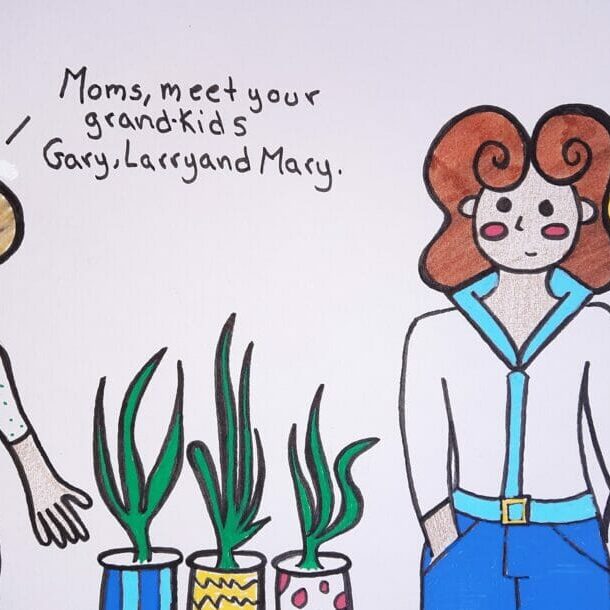
During the height of the pandemic, people started buying house plants and using them to help traverse the stressful landscape of COVID-19. A 2020 CTV News article said seeds were ”Canada’s latest panic buy,” while a 2021 CBC News report called houseplants a “hot, hot trend and a lifeline in the pandemic.” What started the plant frenzy and how is it faring?
I don’t own any houseplants; indoor plants are a strange thing for me. Growing up in Nairobi, Kenya, everyone I knew had fairly sizable gardens filled with guava, avocado and mango trees, not to mention flowers to no end. It was only when I moved to Canada that having houseplants began to make sense.
Many plants aren’t designed to last outside year-round in Canada’s distinct four-season weather. With modern utilities we’re able to control temperature and humidity in our living spaces, increasing the longevity of our houseplants.
There have been many homes I’ve been invited to filled with flashes of green, plants on every windowsill or scattered around in convenient places. One thing I’ve noticed since COVID-19 restrictions eased and I’m visiting more people is the number of houseplants in my friends’ homes. The numbers have definitely increased.
COVID-19 aftermath
During the pandemic, it seemed like everyone was looking to pass the time. Just as there are COVID puppies and COVID babies, there are COVID plants. This isn’t to say houseplants were a rarity in a pre-pandemic world, but rather a wider variety of houseplants have become accessible. For some, they even fulfill the role of pets.
According to a survey by Craft Jack, a contractor marketing firm, 61 per cent of respondents under 40 years old believe plants are the new pets and pets are the new children. The study gathered information from 1,111 American houseplant owners ranging in age from 18 to 68.
It makes sense in some ways. Potted plants need care. They need to be watered, pruned and repotted when necessary. In that sense, they are not that dissimilar to a cat or dog (perhaps less labour-intensive).
Quarantine was a hard time for many people and our collective mental health suffered. The inability to go outside when I needed to was one of the hardest things I came to terms with. While not everyone enjoys the outdoors, being stuck inside showed me how much I took the outside world for granted.
It runs deeper than just the ability to go outside though.

Plants and moods
Seasonal Affective Disorder (SAD) has always been around, even before it was labelled as such. SAD is linked to reduced sunlight during autumn and winter months. An article by Psych Central suggests the changing colours during these seasons impact mood. Having plants in one’s living space might alleviate seasonal depression by reviving the springtime aesthetic. Bright green leaves add a sunny touch of summer during cold grey months.
Third-year Saint Mary’s University student Sapir Gadilov believes plants changed her life. She was spending a lot of time in her room with the curtains drawn to deal with life. She felt the darkness of her room was a representation of how she felt about negative feelings overtaking her life during COVID-19.
When plants came into her life, they served as motivation to bring light into her room.
“I don’t enjoy the dark anymore. Now, I really need the light for myself,” Gadilov said.
Gadilov’s love of plants isn’t restricted to illuminating her life or using plants to cope with emotions. Like all hobbies and passions, there’s an opportunity to connect with others who are also interested.
“I just became really passionate about it. It gave me something to talk about with people,” Gadilov said.
I, being “people”, spent the good part of one morning chatting with Gadilov and learning all I could about her plants. It got us talking about the sudden popularity of house plants.
Are people more conscious of our impact on the environment? Is it for aesthetic? Maybe it’s because plants are infinitely cheaper than pets in the long run. Gadilov thinks it’s a bit of them all.
“We subconsciously care a little bit more about the environment,” Gadilov said.
Are plants the new pets?
Plants seem to bring out a nurturing side of us in the same way owning a cat or dog does. Plants require attention and they require us to learn to care for something outside ourselves. Not to mention it’s a great alternative for someone with pet allergies.
While I don’t think houseplants will eclipse pets anytime soon, I do think plants are the new pets for some people.
I see more of the people around me starting to value plants, even if it’s just for the home aesthetic. I believe if we take the chance to capitalize on this love of plants, we might be able to change the situation around us. After all, if we all loved plants, the world would be a little greener.






